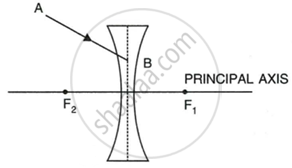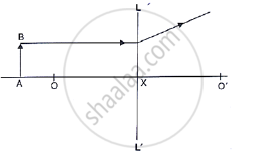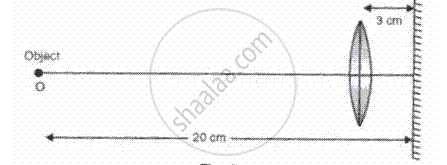Advertisements
Advertisements
प्रश्न
A ray of light incident on a lens parallel to its principal axis, after refraction passes through or appears to come from ______.
पर्याय
Its first focus
Its optical entre
Its second focus
The centre of curvature of its second surface
उत्तर
A ray of light incident on a lens parallel to its principal axis, after refraction passes through or appears to come from its second focus.
APPEARS IN
संबंधित प्रश्न
In figure, (a) and (b), F1 and F2 are the two foci of thin lenses and AB is the incident ray. Complete the diagram to show the path of the ray AB after refraction through each lens.
 |
| (a) |
 |
| (b) |
Study the diagram shown in Fig. 5.56
where is the object located?

In the following diagram , the object and the image formed by the respective lenses are shown. Complete the ray diagram, and locate the focus. Find the focal length of the lens.

Make the rrect choices in the following items :
An object is placed 50 cm from a connverging lens of focal length 30 cm. The image produced would be
Make the rrect choices in the following items :
ln fig, , a real image of a point objert O is formed, Which of the following statements is true about each of the arrangements?

(i) The object is at the principle focus of the lens
(ii) The focal length of the lens is 17 cm
(iii) lf the mirror is moved so that it is 6 cm from the lens image will also move
Make the correct choices in the following items :
The image formed by a diverging lens, shown in fig, , is

How will you differentiate between a convex and a concave lens by looking at a printed page?
The diagram showed a lens as a combination of one glass block and two prisms. Complete the ray diagram and show the part of the incident ray AB after passing through the lens.
(i) Name of the lens formed by the combination.
(ii) What is the line XX’ called?
(iii) Mark the focus F.

Complete the following diagram and state what happens to the ray of light after refraction through the lens.

